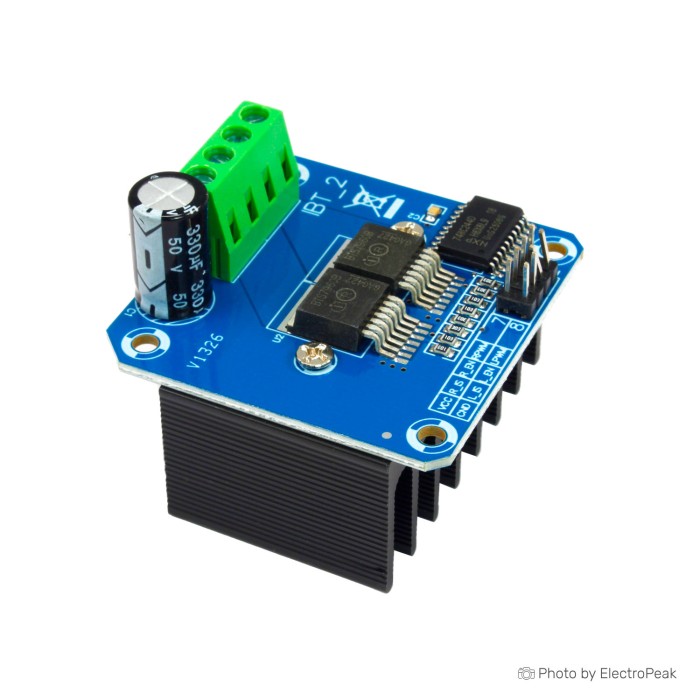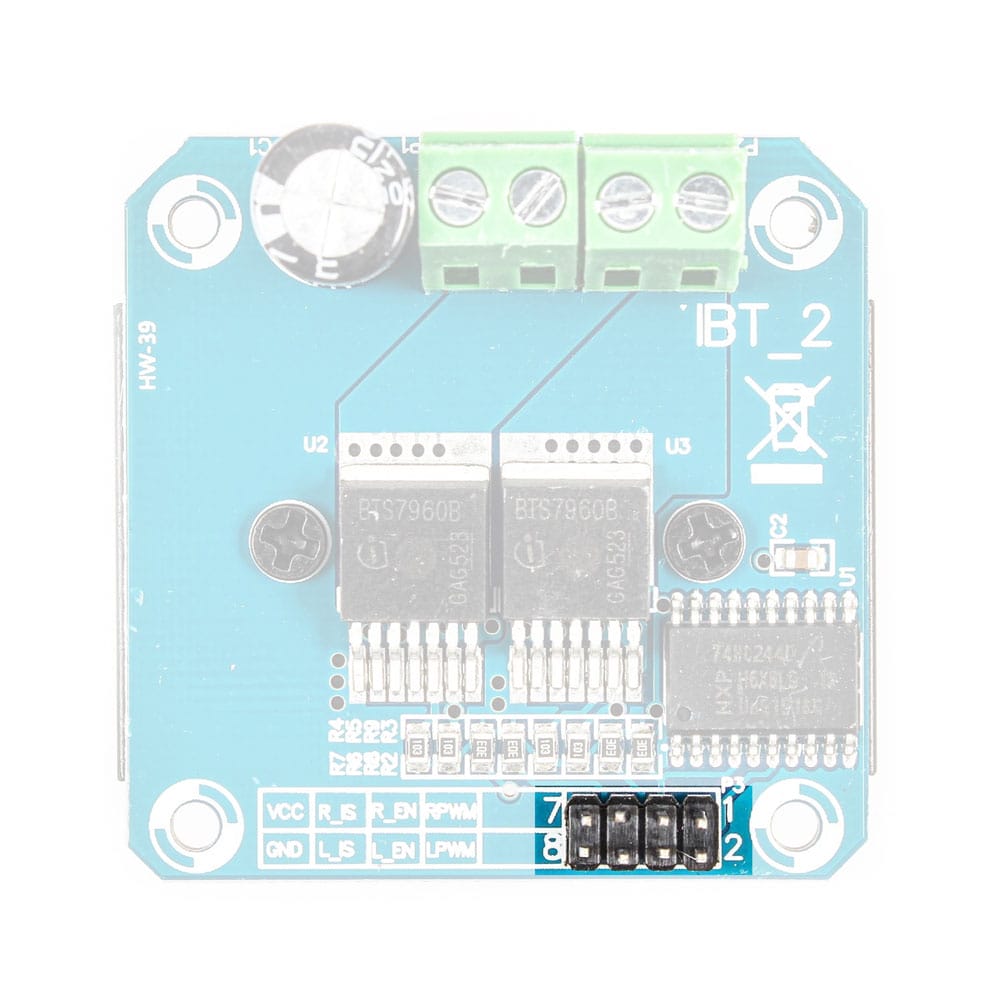No. To charge batteries, you need a power supply with controlled voltage and current. This module is designed to control the DC motors.
BTS7960 43A High Power Motor Driver Module
Volume discounts:
- +25 4 % $2.8300
- +100 6 % $2.7700
- +300 8 % $2.7100
- +500 10 % $2.6500
- +1000 12 % $2.5900
 CJMCU TB6612 DC/Stepper Motor Driver
Previous
CJMCU TB6612 DC/Stepper Motor Driver
Previous

The BTS7960 is a type of H-bridge motor driver, commonly used for controlling the speed and direction of DC motors. In particular, the BTS7960 motor driver module is based on the BTS7960B integrated circuit, which is designed for use in automotive applications but is also widely utilized in robotics, automation, and other projects.
Specifications of BTS7960 43A High Power Motor Driver Module
Here are typical technical specifications for a BTS7960 43A High Power Motor Driver Module:
- Motor Driver Chip: BTS7960
- Operating Voltage: Typically supports a wide operating voltage range, such as 5V to 27V.
- Maximum Continuous Current per Channel: 43A (per channel)
- Peak Current (Short Duration): The peak current handling might be higher than the continuous current, depending on the specific model.
- PWM Frequency: Up to 25 kHz, often configurable through an external microcontroller.
- Working Duty Cycle: 0 ~100%.
- Logic Voltage: Typically compatible with both 3.3V and 5V microcontrollers.
- Control Interface: PWM control for speed, and direction control through two input pins (forward and reverse).
- Current Sensing: Includes current sensing for feedback or protection
- Over-voltage Lock Out. Under-voltage Shut Down.
- Standby Current: Low standby current consumption for power efficiency, especially in battery-powered applications.
- Dimensions (mm): 50 x 50 x 43
- Weight: ~66g
Key features of BTS7960 43A High Power Motor Driver Module
Here are some key features of BTS7960 43A High Power Motor Driver Module:
- H-Bridge Configuration: The BTS7960B is configured as an H-bridge, allowing bidirectional control of DC motors. This enables the motor to be driven in both forward and reverse directions.
- Dual Motor Control: The BTS7960B is a dual-channel motor driver, meaning it can independently control two separate DC motors. This feature is useful in applications requiring the control of multiple motors.
- High Current Handling: One of the notable features of the BTS7960B is its ability to handle relatively high currents. This makes it suitable for driving motors with substantial power requirements.
- PWM Speed Control: The motor speed is controlled using Pulse Width Modulation (PWM) signals. By adjusting the duty cycle of the PWM signal, the average voltage applied to the motor terminals changes, allowing for precise speed control.
- Overcurrent Protection: The BTS7960B typically includes built-in overcurrent protection to prevent damage to the motor driver and connected motors in the event of excessive current flow.
- Over temperature Protection: The motor driver is equipped with overtemperature protection to safeguard against overheating. This feature helps prevent damage to the driver and ensures reliable operation under varying environmental conditions.
- Low Standby Current: The BTS7960B is designed to have low standby current consumption, which is beneficial for applications where power efficiency is important, especially in battery-operated systems.
- Versatility: Due to its versatile design, the BTS7960B motor driver finds applications in various projects, including robotics, electric vehicles, industrial automation, and other systems requiring precise motor control.
- Compact Size: The BTS7960B is often available in compact module form, making it easy to integrate into different projects and reducing the overall footprint of the motor control system.
BTS7960 43A High Power Motor Driver Module Pinout
Here's input pinout of BTS7960 43A High Power Motor Driver Module:
- RPWM: Forward Level or PWM signal, Active High
- LPWM: Reverse Level or PWM signal, Active High
- R_EN: Forward Drive Enable Input, Active High/ Low Disable
- L_EN: Reverse Drive Enable Input, Active High/Low Disable
- R_IS: Forward Drive, Side current alarm output
- L_IS: Reverse Drive, Side current alarm output
- Vcc: +5V Power Supply microcontroller
- Gnd: Ground Power Supply microcontroller
Usage Tips of BTS7960 43A High Power Motor Driver Module
When using the BTS7960 43A High Power Motor Driver Module, here are some tips to ensure proper usage and maximize its performance:
- Power Supply Voltage: Ensure that the power supply voltage is within the specified operating range mentioned above. Operating the module outside the recommended voltage range may result in damage.
- Motor Specifications: Match the motor specifications with the capabilities of the BTS7960 module. Check the voltage and current requirements of your DC motors to ensure compatibility.
- Current Sensing: Utilize the current sensing feature to monitor the current flowing through the motors. This can be useful for feedback control and protection purposes.
- Enable/Disable Functionality: Take advantage of the enable/disable function (EN pin) to selectively turn the motor driver on or off. When no force is applied to the motor and you can turn it off, use this to prevent the motors from overheating.
- Heat Dissipation: The BTS7960 module may generate heat during operation. Provide adequate heat sinking or cooling measures if necessary, especially if operating at high currents or for extended periods.
- Physical Mounting: Securely mount the module, ensuring good electrical connections and preventing shorts. Pay attention to the module's physical orientation and mounting holes.
- Testing and Calibration: Before integrating the motor driver into your main system, perform initial testing and calibration to ensure proper functionality. Confirm that the motors respond as expected to control signals.
- Grounding: Properly connect the ground (GND) of the motor driver to the ground of your control circuit. Maintaining a common ground reference is essential for stable operation.
If you want to learn more about this module and how to use it, you can read œInterfacing BTS7960 43A High Power Motor Driver Module with Arduino.
What you will need to use this motor driver module?
To use the BTS7960 43A High Power Motor Driver Module, you will need several components and considerations to ensure proper functionality and safety in your motor control system. Here's a general list of what you'll need:
- DC Motors: Choose DC motors that are compatible with the voltage and current ratings supported by the BTS7960 module. Ensure that the motor specifications match the capabilities of the motor driver.
- Power Supply: Provide a stable and regulated power supply within the specified voltage range mentioned above. The power supply should be capable of delivering the required current for the motors. You can choose and buy power supply from here.
- Microcontroller or PWM Source: Use a microcontroller or any PWM signal source to generate control signals for the motor driver. This can be an Arduino, Raspberry Pi, ESP32/ESP8266 or any other microcontroller platform capable of generating PWM signals.
- Control Interface Wiring: Connect the PWM and direction control pins of the motor driver module to the corresponding pins on your microcontroller. Ensure correct wiring for motor speed and direction control.
- Motor Wiring: Connect the DC motors to the output terminals of the motor driver module. Pay attention to the polarity to ensure the motors rotate in the desired direction.
FAQs
Can I charge battery using this module?
Can I drive a DC motor with Arduino without using such motor driver modules?
No. Most of microcontrollers capable of handling up to 100~200mA current totally on all pins. That means each pin can handle just about 25mA. Generally, such current is not enough to drive DC motors.
Is the BTS7960 suitable for bidirectional motor control?
Yes, the BTS7960 is configured as an H-bridge, enabling bidirectional control of DC motors. This means you can control the motor in both forward and reverse directions.
Can I use this module to build a radio controlled drones?
While the BTS7960 43A High Power Motor Driver Module is suitable for motor control in various applications, it may not be the most appropriate choice for building a radio-controlled drone. Drones, especially multirotor aircraft like quadcopters, have specific requirements that go beyond what the BTS7960 module provides. Here are some considerations:
- Motor Type: The BTS7960 is designed for DC motors, and typical drones use brushless DC motors. Brushless motors require Electronic Speed Controllers (ESCs) that are specifically designed for them. These ESCs often include features like motor timing adjustment and are more suited for high-speed and dynamic applications.
- Motor Control Precision: Drones require precise motor control for stable flight and maneuverability. Dedicated drone ESCs are designed to handle the rapid changes in motor speed required for aerial maneuvers. They often incorporate advanced algorithms and control mechanisms to achieve stability.
If you're looking to build a radio-controlled drone, it's recommended to use dedicated drone ESCs that are compatible with brushless DC motors and designed to work seamlessly with drone flight controllers. Additionally, consider an integrated flight controller that supports your specific drone application.






Please complete your information below to login.
Sign In
Create New Account